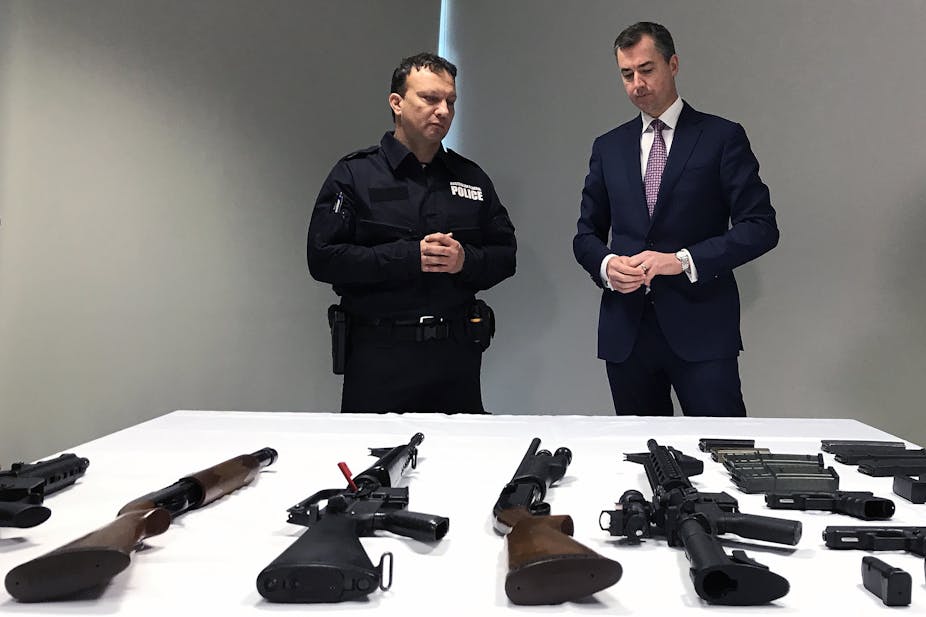After 18 months of false starts, Australia is about to hold another gun amnesty for three months from July 1.
Last week, Justice Minister Michael Keenan claimed the amnesty would take illegal guns off Australian streets. He went on to link the amnesty with terrorism, citing the Lindt Cafe siege and the murder of Curtis Cheng as examples.
In a time when the spectre of terrorism is increasingly used as both a shield to prevent scrutiny of policies and a sword to attack anybody who criticises government decisions, we would do well not to accept at face value Keenan’s claims. So, are gun amnesties an effective way of tackling serious criminal activity?
What is an ‘illegal gun’?
To legally own a firearm in Australia, you must have a licence.
Since 1996, all firearms must be registered. Unregistered firearms are illegal.
Anyone who possesses a firearm without holding a licence, or without the appropriate category of licence for that firearm, is in illegal possession.
“Illegal guns” occur in many different situations. These range from licence holders who may have registered some – but not all – of their firearms after that requirement was introduced, to people whose licence has expired but who still have registered guns, to people who would never be able to obtain a firearm licence but nevertheless possess prohibited firearms.
How will the amnesty work?
Each state and territory is responsible for its own amnesty. It is likely they will look similar to the many amnesties that have run around Australia on a periodic – and sometimes permanent – basis in the last 20 years.
There has been no modelling of how many firearms are likely to be handed in, and the numbers collected under past amnesties vary greatly. Unlike 1996, there will be no government-funded compensation scheme.
Although guesstimates abound, there is no way of knowing how many illegally owned firearms exist. There are no accurate records of how many firearms were in Australia before gun laws changed in 1996.
Even though there are figures for the number of guns handed in under previous amnesties, we cannot say what that translates to as a percentage of the total pool of illegal firearms.
We also have no knowledge about how many guns flow into the black market through means such as illegal manufacture or illegal importation.
Do amnesties reduce gun crime?
Despite talking up the amnesty, Keenan also said it is:
… probably not going to be the case [that] we would have hardened criminals who have made a big effort to get a hand on illegal guns [who] would necessarily be handing them in.
This explains why gun amnesties are not a particularly effective response to firearm crime. Australian and international evidence suggests the people who respond to amnesties are characteristically “low risk”: they are not the ones likely to be involved in violence.
It may sound clichéd to say that “high risk” people do not hand in their guns, but it also appears to be correct.
What about organised crime and terrorism?
Illegal firearms are found in a range of criminal activities, including organised crime and incidents described as “terrorism”.
The argument runs that by reducing the number of guns, amnesties will reduce the number that are stolen and curtail the ability of high-risk individuals – “hardened” criminals or otherwise – to get their hands on black market guns.
However, available evidence does not support arguments about theft as a key source of crime gun supply. Although little data is publicly released about crime gun sources, what we know suggests theft accounts for less than 10% of guns traced in relation to criminal activity.
Problematically, many guns come from “unknown” sources. For example, there was no record of the sawn-off shotgun used in the Lindt Cafe siege ever legally entering the country, and it seems the revolver used to murder Curtis Cheng has equally vague origins.
We also know from international studies that criminals are resourceful and highly adaptable. When one source of firearm supply closes off, they typically have networks enabling them to switch to alternative sources.
This is part of the reason why tackling criminal possession of firearms is so challenging. And when we think about the drivers of demand for illegal guns as well as supply, responding becomes even more difficult.
This is why it is disappointing that Australian thinking follows such predictable, well-trodden paths. It seems politicians and bureaucrats tasked with developing firearm policies have little interest in new, innovative, and evidence-based responses to complex problems, and would rather just do more of what they have been doing for decades.
By all means run amnesties. There is no harm in them. They provide a great means for people who want to obey the law to get rid of guns that are unwanted or that they may not legally possess.
But let’s be realistic about what amnesties are, and are not, likely to deliver.

